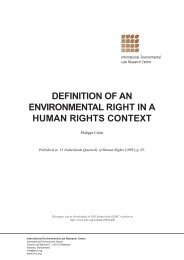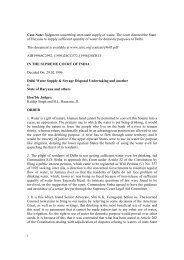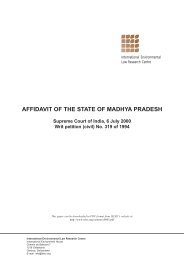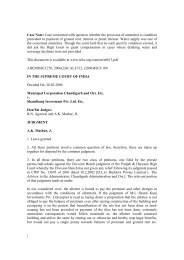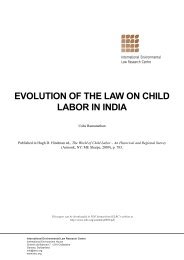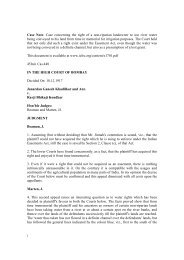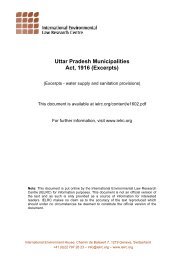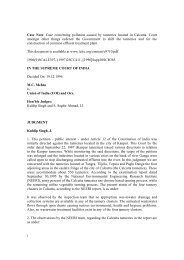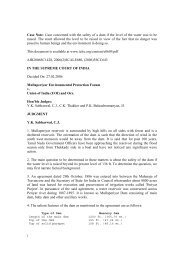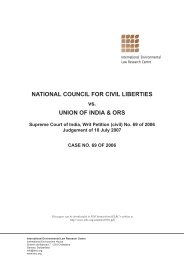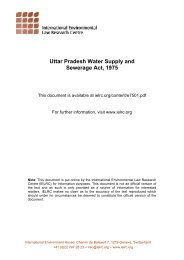175. When compared to other similar major projects, the Sardar Sarovar Project has the least ratio <strong>of</strong> submergenceto the area benefited (1.98 percent only). The ratio <strong>of</strong> some <strong>of</strong> the existing schemes is as much as 25 percent as canbe seen from the table below:Sr. Name <strong>of</strong> project State Benefit Submergence Irrigation Percentage <strong>of</strong>No. area (in ha) area (in ha) benefit per ha area submergedsubmergence to area irrigated1. Hirakud Orissa 2,51,150 73,892 3.40 29.422. Shriramsagar Andhra Pradesh 2,30,679 44,517 5.24 19.143. Gandhisagar Madhya Pradesh 5,03,200 66,186 7.60 13.154. Paithan Maharashtra 2,78,000 35,000 7.94 15.295. Tungbhadra Karnataka 3,72,000 37,814 9.84 10.166. Pench Maharashtra 34,000 7,750 12.13 8.247. Nagarjunsagar Andhra Pradesh 8,95,000 28,500 31.40 3.188. Bhakra Himachal Pradesh 6,76,000 16,800 40.24 2.489. Sardar Sarovar Gujarat 19,03,500 37,533 50.71 1.97176. Countering the assertion that the construction <strong>of</strong> the dam would result in large scale relocation and uprooting<strong>of</strong> tribals, the factual position seems to be that the tribals constitute the bulk <strong>of</strong> PAFs in Gujarat and Maharashtra,namely, 97 percent and 100 percent respectively. In the case <strong>of</strong> Madhya Pradesh, the tribals PAFs are only 30percent while 70 percent are non-tribals.177. The tribals who are affected are in indigent circumstances and who have been deprived <strong>of</strong> the modern fruits<strong>of</strong> development such as tap water, education, road, electricity, convenient medical facilities, etc. The majority <strong>of</strong>the project affected families are involved in rain-fed agricultural activities for their own sustenance. There ispartial employment in forestry sector. Since the area is hilly with difficult terrain, they are wholly dependent onvagaries <strong>of</strong> monsoon and normally only a single crop is raised by them. Out <strong>of</strong> the PAFs <strong>of</strong> Madhya Pradesh whohave re-settled in Gujarat, more than 70 percent are tribal families. Majority <strong>of</strong> the total tribal PAFs are stated tohave already been re-settled in Gujarat after having exercised their option. It is the contention <strong>of</strong> the State <strong>of</strong>Gujarat that the tribals in large number have responded positively to the resettlement package <strong>of</strong>fered by that state.178. In Madhya Pradesh, the agricultural lands <strong>of</strong> the tribal villages are affected on an average to the extent <strong>of</strong> 28percent whereas in the upper reaches i.e. Nimad where the agriculture is advanced, the extent <strong>of</strong> submergence, onan average, is only 8.5 percent. The surveys conducted by HMS Gaur University (Sagar), the Monitoring andEvaluation Agency set up by Government <strong>of</strong> Madhya Pradesh, reveals that the major resistance to relocation isfrom the richer, non-tribal families <strong>of</strong> Nimad who fear shortage <strong>of</strong> agricultural labour if the landless labourersfrom the areas accept resettlement.179. The displacement <strong>of</strong> the people due to major river valley projects has occurred in both developed and developingcountries. In the past, there was no definite policy for rehabilitation <strong>of</strong> displaced persons associated with the rivervalley projects in <strong>India</strong>. There were certain project specific programmes for implementation on temporary basis.For the land acquired, compensation under the provisions <strong>of</strong> Land Acquisition Act, 1894 used to be given to theproject affected families. This payment in cash did not result in satisfactory resettlement <strong>of</strong> the displaced families.Realising the difficulties <strong>of</strong> displaced persons, the requirement <strong>of</strong> relief and rehabilitation <strong>of</strong> PAFs in the case <strong>of</strong>Sardar Sarovar Project was considered by the <strong>Narmada</strong> Water Disputes Tribunal and the decision and final order<strong>of</strong> the Tribunal given in 1979 contains detailed directions in regard to acquisition <strong>of</strong> land and properties, provision<strong>of</strong> land, house plots and civic amenities for the resettlement and rehabilitation <strong>of</strong> the affected families. Theresettlement policy has thus emerged and developed along with Sardar Sarovar Project.37
180. The Award provides that every displaced family, whose more than 25 percent <strong>of</strong> agricultural land holding isacquired, shall be entitled to and be allotted irrigable land <strong>of</strong> its choice to the extent <strong>of</strong> land acquired subject to theprescribed ceiling <strong>of</strong> the State concerned with a minimum <strong>of</strong> two hectares <strong>of</strong> land. Apart from this land basedrehabilitation policy, the Award further provides that each project affected person will be allotted a house plot free<strong>of</strong> cost and resettlement and rehabilitation grant. The civic amenities required by the Award to be provided atplaces <strong>of</strong> resettlement include one primary school for every 100 families, one Panchayat Ghar, one dispensary, oneseed store, one children’s park, one village pond and one religious place <strong>of</strong> worship for every 500 families, onedrinking water well with trough and one tree platform for every 50 families, approach road linking each colony tomain road, electrification, water supply, sanitary arrangement, etc. The State Governments have liberalised thepolicies with regard to resettlement and have <strong>of</strong>fered packages more than what was provided for in the Award e.g.the Governments <strong>of</strong> Madhya Pradesh, Maharashtra and Gujarat have extended the R&R benefits through theirliberalised policies even to the encroachers, landless/displaced persons, joint holders, tapu land (island) holdersand major sons (18 years old) <strong>of</strong> all categories <strong>of</strong> affected persons. The Government <strong>of</strong> Maharashtra has decidedto allot one hectare <strong>of</strong> agricultural land free <strong>of</strong> cost even to unmarried daughters <strong>of</strong> all categories <strong>of</strong> PAFs.181. In the environmental clearance granted by the Ministry <strong>of</strong> Environment and Forests vide its letter dated 24June 1987, one <strong>of</strong> the conditions stipulated therein was for information from the project authorities on variousaction plans including Rehabilitation Master Plan <strong>of</strong> 1989.182. It is the contention <strong>of</strong> the petitioners that the failure to prepare a master plan constitutes non-compliance withthe requirement <strong>of</strong> the Tribunal’s Award as well as environmental clearance. The Tribunal’s Award does not usethe expression ‘Master Plan’ but as per Clause XI Sub-clause IV(2)(ii), what is required, is as under:The three States by mutual consultation shall determine within two years <strong>of</strong> the decision <strong>of</strong> the Tribunal,the number and general location <strong>of</strong> rehabilitation villages required to be established by Gujarat in itsown territory.183. It is with regard to this clause in the Award that, presumably the aforesaid letter <strong>of</strong> 24 June 1987 grantingenvironmental clearance required the preparation <strong>of</strong> the new Master Plan.184. In 1988 when the project was first cleared by the Planning Commission from investment angle. It wasestimated that 12,180 families would be affected in three States. Based on these numbers, the State Governmentsindependently prepared their action plans and announced their R&R policy based on Tribunal’s Award. On thebasis <strong>of</strong> the said action plans the <strong>Narmada</strong> Control Authority submitted Rehabilitation Master Plan to the Ministry<strong>of</strong> Environment and Forests along with its letter dated 3/4.5.1989. Out <strong>of</strong> the total population, which is affected bythe submergence, large number are tribals and hence attention was paid by the State Governments to liberalisetheir policies for protecting the socio-economic and cultural milieu and to extend the R&R benefits even to othercategories <strong>of</strong> persons who were not covered by the Tribunal’s Award. This led to the liberalisation <strong>of</strong> the R&Rpackages by the three States which packages have been referred to hereinabove. As a result <strong>of</strong> the liberalisation <strong>of</strong>the packages, the number <strong>of</strong> PAFs as estimated in 1992 by the State Governments were 30,144. Based on thematerial available, the three State Governments prepared individual action plans in 1993 but those action planswere integrated by the <strong>Narmada</strong> Control Authority first in 1993 and again in 1995 as an integrated Master Plan topresent a holistic picture <strong>of</strong> the R&R programme. The Master Plan deals with socio-economic and cultural milieu<strong>of</strong> PAFs, the legal framework, the R&R policy and procedures, implementation machinery, organisation <strong>of</strong> R&R,monitoring and evaluation, empowerment <strong>of</strong> women and youth, special care for vulnerable groups, financial plansfor R&R etc. As per the 1990 Master Plan the total PAFs have increased to 40,227 from 30,144 due to addition <strong>of</strong>100 more genuine PAFs in Maharashtra. This Master Plan includes village-wise, category-wise PAFs and theirpreference in R&R to settle in home State or in Gujarat.The reason for increase in number <strong>of</strong> PAFs has been explained in the Master Plan and the reasons given, inter alia,are:(a) After CWC prepared backwater level data, the number <strong>of</strong> PAFs in Madhya Pradesh (MP) increased by 12,000PAFs as their houses are affected in a 1 in 100 years flood.(b) Government <strong>of</strong> Gujarat (GoG) included major sons <strong>of</strong> the dyke villages as PAFs.(c) Cut-<strong>of</strong>f date for major sons was extended by GoG and Government <strong>of</strong> Maharashtra (GoM).38



